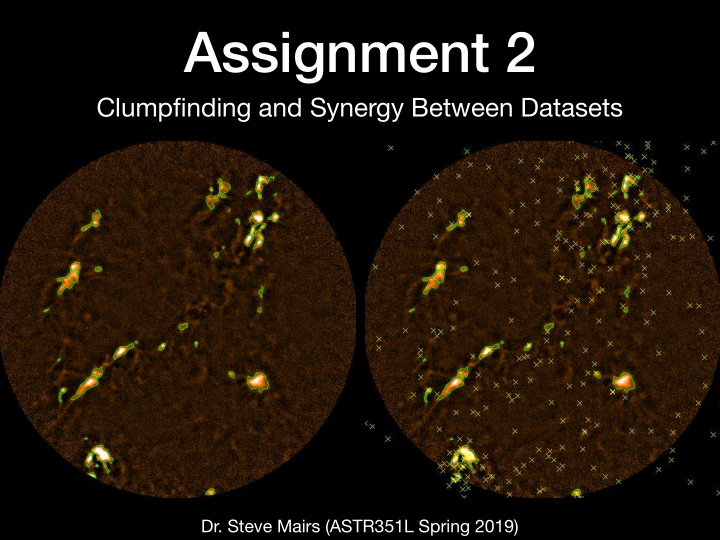



Assignment 2 Clumpfinding and Synergy Between Datasets Dr. Steve Mairs (ASTR351L Spring 2019)
Overview Unstable? 1. Star Formation 2. YSOs 3. Clumpfinding 4. Catalogues Fragmentation 5. Mass Equations
Star Formation in a Nutshell
Orion at 850 μ m We have a picture, what we need is a movie
Star Formation in a Nutshell
Orion at 850 μ m We have a picture, what we need is a movie
Submm - The James Clerk Maxwell Telescope, Dense Gas/Dust Herschel Space Observatory Conglomerates CARMA ALMA Instruments to measure gas and dust Ring-like Structures ?
Star Formation in a Nutshell
Young Stellar Objects: YSOs We use infrared telescopes to identify and classify YSOs The class is proportional to age! We expect to see Class 0/I associated with SCUBA-2 clumps (early SF!) These data have a lot of synergy With the JCMT’s!
Clumpfinding: The FellWalker Algorithm The FellWalker algorithm is tuned to identify compact, localised emission Each pixel is considered in an image and the steepest gradients up to an emission peak are identified Checks are performed to ensure the peak is not a noise spike
Clumpfinding: The FellWalker Algorithm The local maximum is assigned an identifying integer and all the pixels above a user-defined threshold that were included in the path to the peak are assigned the same integer. Clumps are split up based on the depth of the dips between peaks
Clumpfinding: The FellWalker Algorithm FellWalker Results Overplotted The FellWalker “Outmap” 28 9 4
FellWalker(/Starlink) Catalogues Along with a map of all the clumps, you get all their properties! Peak1, Peak2 = Location of the peak Cen1, Cen2 = Location of the centre of the clump Size1, Size2 = Weighted average size along each axis Sum = Flux from all pixels in the clump simply added up together Peak = Flux of the peak pixel contained within clump Volume = Area in 2D
FellWalker(/Starlink) Catalogues **** PAY ATTENTION TO UNITS **** Note that a proper total flux is in units of mJy or Jy In the example above, the units are mJy/arcsec 2 So you need to multiply by the area of a pixel! (In arcsec 2 )
The Physics of Stability: Mass Begin with a modified blackbody equation to describe the flux: I ν = B(T d ) x [1 - e - 𝞄 ν ] Flux at frequency ν Optical Depth Dust Temperature Planck Equation We are on the Rayleigh Jeans tail of the blackbody ( 𝞄 ν << 1): So, Taylor Expand e - 𝞄 ν I ν = B(T d ) x [1 - (1 - 𝞄 ν )] I ν = B(T d ) x 𝞄 ν
The Physics of Stability: Mass Rayleigh Jeans Tail * JCMT
The Physics of Stability: Mass Let’s take a look at the total flux, S ν : Add flux S ν = ∫ I ν d Ω Over solid angle Of source S ν = ∫ B(T d ) x 𝞄 ν d Ω S ν = B(T d ) x 𝞄 ν x Ω Column 𝞄 ν = N σ ν Density Number density 𝞄 ν = N ⍴ 𝜆 ν / n of core Mass density Opacity of 𝞄 ν = N μ m H 𝜆 ν of core core S ν = B(T d ) x N μ m H 𝜆 ν x Ω
The Physics of Stability: Mass S ν = B(T d ) x N μ m H 𝜆 ν x Ω Mean Molecular Weight x 2D Area of core Mass of Hydrogen Distance to core S ν = B(T d ) x (M/r 2 ) μ m H 𝜆 ν x (r 2 /D 2 ) Mass of core S ν = (2hv 3 /c 2 ) x {1/[exp(hv/k B T d ) - 1]} x M μ m H 𝜆 x (1/D 2 ) Solve for the mass of the core, M, combine constants, change units….
The Physics of Stability: Mass M 345GHz = 0.074 x (S 345GHz /1 Jy) x (D/100 pc) 2 x ( 𝜆 345GHz /0.01 cm 2 g -1 ) x [exp(17 K / T d ) - 1] M ☉ Good 𝜆 345GHz = 0.01 cm 2 g -1 Good T d = 15 K S 345GHz comes from FellWalker Catalogue (“Sum”) - but check the units!! Find the distance, D, to the Orion Nebula
The Physics of Stability: Jeans Mass
Gravity Stronger Pressure More Heat = = Expansion Expansion = = No star formation No star formation Stronger Gravity More Stuff = = Collapse Collapse = = Star Formation Star Formation Thermal Pressure A constant struggle!
The Physics of Stability: Jeans Mass Jeans Mass: The maximum mass a core can have before collapsing under its own gravity if there is only thermal pressure trying to prevent It can be beautifully derived from first principles just using the continuity equation and Euler’s equation (but I’ll spare you the horror) Mass of core < Jeans Mass: Oscillating Wave Solution Mass of core >/= Jeans Mass: Runaway Collapse!
The Physics of Stability: Jeans Mass The Jeans mass, M J , in a nice, approximate form: M J = 2.9 x (15 K / T d ) x (R / 0.07 pc) M ☉ Radius of the core assuming it has a spherical configuration **THE UNITS ARE IN PARSECS** M / M J < 1 —————> STABLE TO COLLAPSE M / M J >/= 1 —————> UNSTABLE
Recommend
More recommend